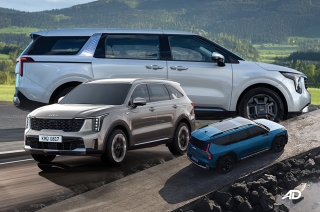
Of all the things that could make or break a car purchase, the test drive is arguably the most important determining factor. In the case of a brand new car, a vehicle that has shown promising specifications and features might not be your cup of tea once you get behind the wheel. For second hand purchases, a car that may look fresh and clean on the outside, might be hiding a few problems under the hood, waiting to be found at the worst moment.
Even though some dealerships may only permit a few laps around the block for a test drive, make sure to keep these tips in mind before signing on the dotted line. Nothing’s worse than having purchased a car that’s bound to sit in the garage, or worse, the service center.

1. Finding the one
In the case of new vehicles, make sure you do your research and find the dealership that has a test drive unit that matches your specifications as closely as possible. After all, you want to have a hand at driving the very car you’ll be purchasing if you end up liking it. Give them a call and request the next available slot to test drive your chosen model. Remember, even slight differences in features can greatly affect the driving experience.
For second hand vehicles, you would’ve already done your research beforehand and found a specific make, model, and trim level that matches your needs, so scheduling a test drive with the seller should be at the top of your priorities.

2. Have a checklist for used vehicles
You want to do the following in a well-lit area, preferably daylight, in order to assess a second-hand vehicle:
- Examine the tires individually. Does each have at least a quarter of an inch of tread? Is the wear even? Are the tires matched in size and brand?
- Look under the car for fluid leaks. Do this with the engine off and again with it running.
- Squat at the front corners of the car and look down along its sides for ripples that might indicate body repairs.
- Open and close all the doors and the trunk. Make sure all operate smoothly.
- Lock and unlock all the doors from inside and out.
- Operate the headlights, brake lights and turn signals as you verify that they work.
- Open the hood with the engine running and listen for knocks, ticks or hisses.
- Lift up the pad or carpet in the trunk and check for rust.
- Slide behind the steering wheel and make sure the controls for every system operate properly. Does the air conditioner cool, does the heater heat, does the infotainment system work?

3. Take it for an easy spin
Once you have the keys and the salesperson or seller is in the car with you, start the car and listen for a few minutes for any weird noises or idling issues before setting off. Once you do start driving the car, start slow and make sure the vehicle feels okay at low speeds. Check steering play and pedal sensitivity. Does the steering pull to one side? Do the pedals feels squishy or have too much play in them?
Low speed driving also highlights any noises or squeaks when turning, which could indicate bearings that need changing. Any weird vibrations coming from the steering wheel when turning can indicate problems down the road.
Get to grips with also maneuvering the vehicle in tight spaces and making tight turns to test out the turning radius. It’s also a good idea to practice parking, making sure visibility is good and any parking features, such as sensors and rear cameras, are in working order.

4. Get close to highway speeds
This may be a bit difficult to do if the dealership or venue where you met to test drive the vehicle is far away from a main road or wide avenue, or even an expressway. If you do have permission or the chance to do so, testing a vehicle at close to 80-100 km/h can highlight its strengths or weaknesses.
High speed stability in the wheel is important, so look out for any vibrations of play at speed. Also listen for any bumps or creaks when going over bumps or dividers. This is also a great time to check the acceleration of the vehicle; does it shift well and not hesitate when speeding up? Do the brakes feel good when slowing down from speed? Does the vehicle maintain a straight line under braking and accelerating? Is there smoke emanating from the exhaust? This would be an excellent time to also play around with any safety technology the vehicle has to offer, such as lane departure warning, blind spot indicators, and cruise control.
If you answer yes to the questions above, then be prepared to run into some maintenance issues if you do decide to purchase the vehicle. At the very least, if you really want the car, talk down the price. If the car is brand new, then look for characteristics that may appeal to you, such as, is it exciting or stable to drive in a variety of conditions? Do all the features suit your lifestyle? If so, sign on the dotted line.
Conclusion
Whatever vehicle you end up taking for a spin, make sure you do research and understand the limitations and highlights of the specific brand or model you’re looking at. A sedan from a certain brand might not meet your needs until you try out another. Also look into costs of maintaining that vehicle, whether new or used. You don’t want it to turn into a money pit or something you can’t keep in tip-top shape for daily use.
Latest Features
-
An all-electric future: The Porsche Macan Electric / Featured Article
Porsche’s Macan goes all-electric; it’s a new beast with an electrified heart, yet unmistakably Porsche in performance and spirit.
-
Which Kia should I buy? / Featured Article
We’re here to help you decide which Kia vehicle is best for you, whether it’s a sedan, crossover, or minivan.
-
Why Lynk & Co is a good option for luxury car buyers / Featured Article
Lynk & Co offers premium value for those exploring the luxury market.
Popular Articles
-
Electric Vehicles in the Philippines for under P1 million
Jerome Tresvalles · Aug 19, 2025
-
Top 3 Cars For Every Lifestyle—What Cars Are Right For You? | Behind a Desk
Caco Tirona · Apr 24, 2024
-
5 Tips to Maximize Fuel Efficiency
Jerome Tresvalles · Sep 09, 2024
-
Five driving habits that are draining your fuel tank
Jerome Tresvalles · Jun 24, 2025
-
Can engine braking harm your engine?
Jerome Tresvalles · Sep 11, 2025
-
Do electric cars even need maintenance?
Jerome Tresvalles · Oct 23, 2024
-
Best vehicles for an active outdoor lifestyle
Shaynah Miranda · Jul 25, 2024
-
How to drive different types of vehicle transmissions
May 23, 2024
-
5 easy ways to keep your car interior clean
Allysa Mae Zulueta · Nov 15, 2021
-
How to survive Metro Manila traffic
Earl Lee · Aug 16, 2022



